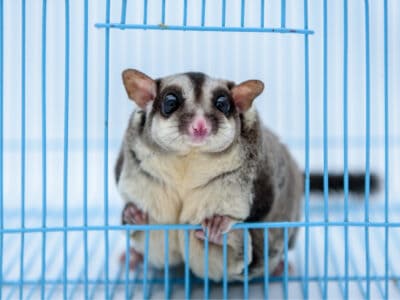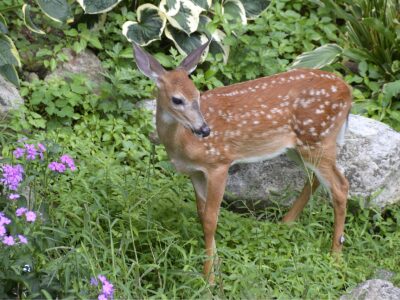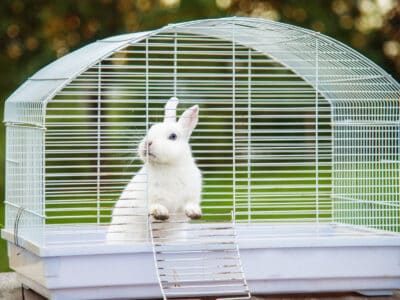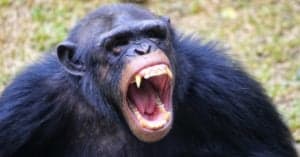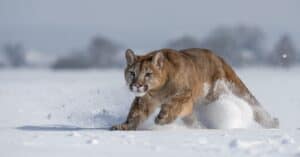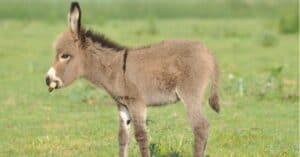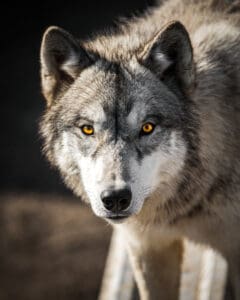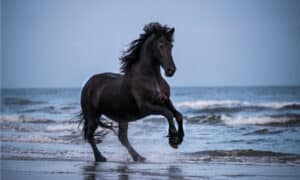Deer vs Reindeer: What Are 8 Key Differences?
@media (min-width: 481px) {
.mobile-top-content {
display: none;
}
}
#mobileTopContentCTACarouselControls { overflow: hidden; text-overflow: ellipsis; white-space: nowrap; }
.mobile-top-content .more { color: #fff; }
.mobile-top-content a { color: #fff; text-decoration: underline; }
.mobile-top-content a:hover { color: #fff; text-decoration: underline; }
@media (max-width: 480px) {
.mobile-top-content {
background-color: #06a10b;
color: #fff;
text-align: center;
/*height: 60px;
padding-top:5px;*/
font-size:80%;
/* display: block; */
margin: 0px -30px;
}
}
Cervidae is a family of hoofed mammals that includes deer and reindeer. The whitetail deer, the most frequent species, is a medium-sized deer, while the reindeer are large species. Here, we’ll look at eight important distinctions between deer and reindeer.
Deer vs Reindeer: A Comparison

A-Z-Animals.com
| Deer | Reindeer | |
|---|---|---|
| Size | 10 ft tall on Average; 90 – 990 lbs. | 5.9 To 6.8 ft Long; 121 To 529 lbs. |
| Colors | White, Browns, Reds, and Tans | Wide Range of Colors from White to Black |
| Physical Features | Males have Antlers | Males and Females have Antlers |
| Danger | May Charge, Kick, or Stomp; Carry Ticks with Diseases | Not Hostile, Often Hunted or Domesticated |
| Diet | Leaves, Twigs, Fruits, Nuts | Lichen, Moss, Herbs, Grass |
| Lifespan | 2 – 5 Years | 10 – 15 Years |
| Habitats | Meadows and Brushy Areas | Arctic Tundra, Boreal Forests |
| Social Habits | Males Lead The Herds, Segregated Sexes Occur Occasionally | Feed, Move, Rest in Herds |
Key Differences Between Deer vs Reindeer
The key differences between deer and reindeer are size, appearance, physical features, habitat, lifespan, and habits. One key distinction between deer and reindeer is that deer are acclimated to mild temperatures, whilst reindeer are adapted to colder climates. Let’s explore these two mammals further!
Deer vs Reindeer: Size
Male reindeer range in size from 28 to 53 inches in height and 5.9 to 6.8 feet in length. The average height of a female is between 5.5 and 6.2 feet. Females weigh between 121 and 308 pounds, while males can weigh as much as 529 pounds. Male deer can weigh as much as 990 pounds. On average, they’re about 10 feet tall.
Deer vs Reindeer: Colors
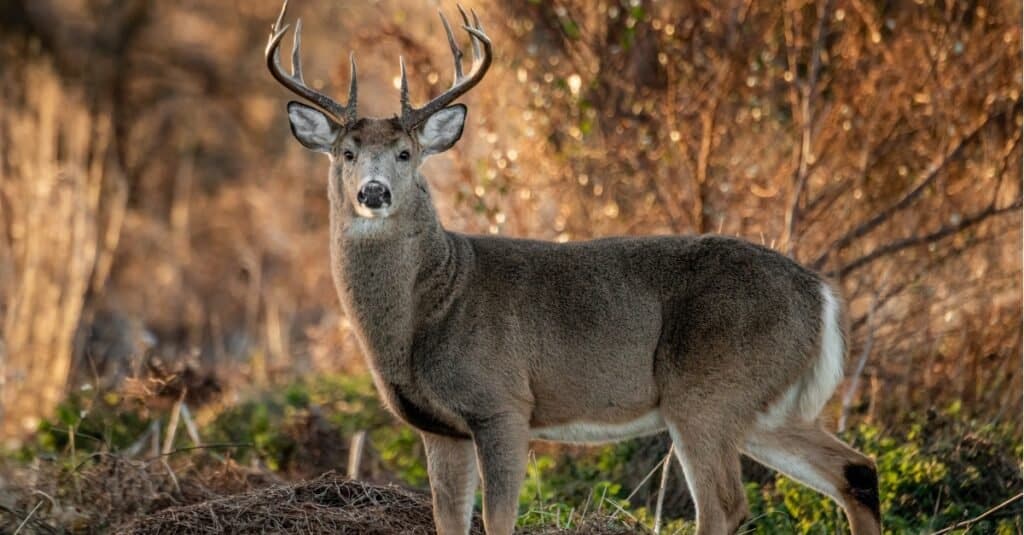
iStock.com/Harry Collins
There are a variety of deer species, and each has a distinct coat color. According to legend, reindeer come in a wide range of hues and sizes. The hue of a reindeer can vary greatly, from nearly black to almost white. A variety of terms refer to these hues. Musical, Suivakko, and Valkko are the names for black, light, and white reindeer in Finnish.
In the summer, the deer’s fur is reddish-brown or tan; in the winter, it’s white. They grow a grayish brown winter coat in place of their summer coat. In addition to the white on its throat, around its eyes and nose, and on its stomach, it has white on the underside of its tail.
Deer vs Reindeer: Physical Features
A deer’s coat has hollow hairs that helps keep it warm in the winter. The fawns’ spotted coats help them hide on the forest floor, while the deer’s ever-changing coat colors help them blend in. The male deer has grown antlers. It’s common to see the same physical features in all deer species, such as the two pairs of hooves on each foot as well as a stomach with four chambers.
With their wide cloven hooves and ability to swim well, reindeer can move easily over snow or squishy terrain. Reindeer have fur on the bottoms of their hooves to prevent them from slipping on ice. They can paddle through rivers and lakes with their large hooves acting as paddles on their powerful, stumpy legs. Using their hooves, they may also be able to dig up food from the snow. The male deer sheds his antlers after the rut in October, while the females wait until spring calving to shed theirs.
Deer vs Reindeer: Danger

Reindeer, despite their unpredictability, are normally not dangerous to humans and are often hunted. They can be domesticated and raised for their fur, meat, and antlers as well as for their dairy and transportation.
Deer can attack humans. If a deer thinks it or its young are in danger, it may charge, kick, or stomp. Antlers can cause bruises, punctures, and skin lacerations. Deer also have ticks that carry diseases like Lyme and brucellosis.
Deer vs Reindeer: Diet
Remarkably, reindeer eat a wide variety of plants, including ferns, herbs, grass, moss shrubs, tree shoots, and leaves. They particularly enjoy willow and birch. Lichen (also known as reindeer moss) and fungi are their primary sources of food in the winter, and they scrape the snow away with their feet to reach it. An adult reindeer’s daily food intake ranges from 9 to 18 pounds of vegetation!
Deer are herbivores who eat a wide variety of plants at a moderate pace. Leaves, twigs, fruits and nuts, grass, grain, alfalfa, lichens, and other fungi can be digested by their stomachs. Pecans, hickory nuts, beechnuts, and acorns are a few of their preferred foods. Apples, blueberries, and blackberries are some of the fruits that deer like.
Deer vs Reindeer: Lifespan
In the wild, reindeer can live up to 15 years. Deer lives 2-5 years. Humans are largely responsible for this shorter life span due to hunting. In the wild, the maximum lifespan is 20 years, but only a few reach 10.
Deer vs Reindeer: Habitat
White-tailed deer can adapt to many situations. Ideal conditions include hardwoods, croplands, brushlands, and pasturelands. Their favored habitats are meadows, woodlots, brushy regions, and croplands. North American caribou (reindeer) live in the Arctic tundra and boreal woods of Greenland, Scandinavia, Russia, Alaska, and Canada. Their fur protects them from the cold.
Deer vs Reindeer: Social Habits
Reindeer herds stay together to feed, move, and rest. These herds can range in size from ten animals to several hundred. As many as 500,000 members of a single herd can be found in springtime. Deer are sociable animals that live in herds and are known for their tight-knit tendencies. In most species, a dominant male leads the herd, however, there are a few instances when the females and males have separate herds.
Wrapping Up Deer vs Reindeer

The entire family of Cervidae is made up of different types of deer. In contrast to other deer species, which prefer milder climates, reindeer have evolved to withstand the extreme cold of northern latitudes. When it comes to having many predators, the deer are no exception. Reindeer, on the other hand, are extremely large and are usually only pursued by humans and bears. Also, in most deer species, only males have antlers. However, in reindeer, both sexes have them.
More from A-Z Animals
.more-snake-card-image { max-height:140px !important; }
@media (min-width: 481px) {
.mobile-top-content {
display: none;
}
}
#mobileTopContentCTACarouselControls { overflow: hidden; text-overflow: ellipsis; white-space: nowrap; }
.mobile-top-content .more { color: #fff; }
.mobile-top-content a { color: #fff; text-decoration: underline; }
.mobile-top-content a:hover { color: #fff; text-decoration: underline; }
@media (max-width: 480px) {
.mobile-top-content {
background-color: #06a10b;
color: #fff;
text-align: center;
/*height: 60px;
padding-top:5px;*/
font-size:80%;
/* display: block; */
margin: 0px -30px;
}
}
Cervidae is a family of hoofed mammals that includes deer and reindeer. The whitetail deer, the most frequent species, is a medium-sized deer, while the reindeer are large species. Here, we’ll look at eight important distinctions between deer and reindeer.
Deer vs Reindeer: A Comparison

A-Z-Animals.com
| Deer | Reindeer | |
|---|---|---|
| Size | 10 ft tall on Average; 90 – 990 lbs. | 5.9 To 6.8 ft Long; 121 To 529 lbs. |
| Colors | White, Browns, Reds, and Tans | Wide Range of Colors from White to Black |
| Physical Features | Males have Antlers | Males and Females have Antlers |
| Danger | May Charge, Kick, or Stomp; Carry Ticks with Diseases | Not Hostile, Often Hunted or Domesticated |
| Diet | Leaves, Twigs, Fruits, Nuts | Lichen, Moss, Herbs, Grass |
| Lifespan | 2 – 5 Years | 10 – 15 Years |
| Habitats | Meadows and Brushy Areas | Arctic Tundra, Boreal Forests |
| Social Habits | Males Lead The Herds, Segregated Sexes Occur Occasionally | Feed, Move, Rest in Herds |
Key Differences Between Deer vs Reindeer
The key differences between deer and reindeer are size, appearance, physical features, habitat, lifespan, and habits. One key distinction between deer and reindeer is that deer are acclimated to mild temperatures, whilst reindeer are adapted to colder climates. Let’s explore these two mammals further!
Deer vs Reindeer: Size
Male reindeer range in size from 28 to 53 inches in height and 5.9 to 6.8 feet in length. The average height of a female is between 5.5 and 6.2 feet. Females weigh between 121 and 308 pounds, while males can weigh as much as 529 pounds. Male deer can weigh as much as 990 pounds. On average, they’re about 10 feet tall.
Deer vs Reindeer: Colors

iStock.com/Harry Collins
There are a variety of deer species, and each has a distinct coat color. According to legend, reindeer come in a wide range of hues and sizes. The hue of a reindeer can vary greatly, from nearly black to almost white. A variety of terms refer to these hues. Musical, Suivakko, and Valkko are the names for black, light, and white reindeer in Finnish.
In the summer, the deer’s fur is reddish-brown or tan; in the winter, it’s white. They grow a grayish brown winter coat in place of their summer coat. In addition to the white on its throat, around its eyes and nose, and on its stomach, it has white on the underside of its tail.
Deer vs Reindeer: Physical Features
A deer’s coat has hollow hairs that helps keep it warm in the winter. The fawns’ spotted coats help them hide on the forest floor, while the deer’s ever-changing coat colors help them blend in. The male deer has grown antlers. It’s common to see the same physical features in all deer species, such as the two pairs of hooves on each foot as well as a stomach with four chambers.
With their wide cloven hooves and ability to swim well, reindeer can move easily over snow or squishy terrain. Reindeer have fur on the bottoms of their hooves to prevent them from slipping on ice. They can paddle through rivers and lakes with their large hooves acting as paddles on their powerful, stumpy legs. Using their hooves, they may also be able to dig up food from the snow. The male deer sheds his antlers after the rut in October, while the females wait until spring calving to shed theirs.
Deer vs Reindeer: Danger

Reindeer, despite their unpredictability, are normally not dangerous to humans and are often hunted. They can be domesticated and raised for their fur, meat, and antlers as well as for their dairy and transportation.
Deer can attack humans. If a deer thinks it or its young are in danger, it may charge, kick, or stomp. Antlers can cause bruises, punctures, and skin lacerations. Deer also have ticks that carry diseases like Lyme and brucellosis.
Deer vs Reindeer: Diet
Remarkably, reindeer eat a wide variety of plants, including ferns, herbs, grass, moss shrubs, tree shoots, and leaves. They particularly enjoy willow and birch. Lichen (also known as reindeer moss) and fungi are their primary sources of food in the winter, and they scrape the snow away with their feet to reach it. An adult reindeer’s daily food intake ranges from 9 to 18 pounds of vegetation!
Deer are herbivores who eat a wide variety of plants at a moderate pace. Leaves, twigs, fruits and nuts, grass, grain, alfalfa, lichens, and other fungi can be digested by their stomachs. Pecans, hickory nuts, beechnuts, and acorns are a few of their preferred foods. Apples, blueberries, and blackberries are some of the fruits that deer like.
Deer vs Reindeer: Lifespan
In the wild, reindeer can live up to 15 years. Deer lives 2-5 years. Humans are largely responsible for this shorter life span due to hunting. In the wild, the maximum lifespan is 20 years, but only a few reach 10.
Deer vs Reindeer: Habitat
White-tailed deer can adapt to many situations. Ideal conditions include hardwoods, croplands, brushlands, and pasturelands. Their favored habitats are meadows, woodlots, brushy regions, and croplands. North American caribou (reindeer) live in the Arctic tundra and boreal woods of Greenland, Scandinavia, Russia, Alaska, and Canada. Their fur protects them from the cold.
Deer vs Reindeer: Social Habits
Reindeer herds stay together to feed, move, and rest. These herds can range in size from ten animals to several hundred. As many as 500,000 members of a single herd can be found in springtime. Deer are sociable animals that live in herds and are known for their tight-knit tendencies. In most species, a dominant male leads the herd, however, there are a few instances when the females and males have separate herds.
Wrapping Up Deer vs Reindeer

The entire family of Cervidae is made up of different types of deer. In contrast to other deer species, which prefer milder climates, reindeer have evolved to withstand the extreme cold of northern latitudes. When it comes to having many predators, the deer are no exception. Reindeer, on the other hand, are extremely large and are usually only pursued by humans and bears. Also, in most deer species, only males have antlers. However, in reindeer, both sexes have them.

